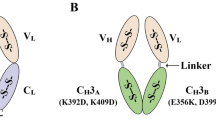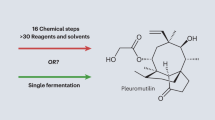Abstract
We have engineered the filamentous fungus Trichoderma reesei to assemble and secrete immunologically authentic engineered Fab antibody fragments into the culture medium. A major improvement in yield was achieved by fusing the heavy Fd chain to the T. reesei cellulase, CBHI. The yields of secreted, immunologically active Fab and CBHI-Fab fusion were 1 mg/1 and 150 mg/1, respectively. The Fab fragment can be released from the fusion protein CBHI-Fab by an extracellular T. reesei protease. There was no detectable difference in affinity for the antigen between the engineered Fab and the idiotypic antibody.
This is a preview of subscription content, access via your institution
Access options
Subscribe to this journal
Receive 12 print issues and online access
$209.00 per year
only $17.42 per issue
Buy this article
- Purchase on Springer Link
- Instant access to full article PDF
Prices may be subject to local taxes which are calculated during checkout
Similar content being viewed by others
References
Plückthun, A. 1991. Antibody engineering Advances from the use of Eschenchia coli expression systems. Bio/Technology 9: 545–551.
Wood, C.R., Boss, M.A., Kenten, J.H., Calvert, J.E., Roberts, N.A. and Emtage, J.S. 1985. The synthesis and in vivo assembly of functional antibodies in yeast. Nature 314: 446–449.
Horwitz, A.H., Chang, C.P., Better, M., Hellstrom, K.E. and Robinson, R.R. 1988. Secretion of functional antibody and Fab fragment from yeast cells. Proc. Natl. Acad. Sci. USA 85: 8678–8682.
Edqvist, J., Keränen, S., Penttilä, M., Stråby, K.B. and Knowles, J.K.C. 1991. Production of functional IgM Fab fragments by Sacchartimyces cerevisiae. J. Biotechnol. 20: 291–300.
Carter, P., Kelley, R.F., Rodrigues, M.L., Snedecor, B., Covarrubias, M., Velligan, M.D., Wong, W.L.T., Rowland, A.M., Kotts, C.E., Carver, M.E., Yang, M., Bourell, J.H., Shepard, H.M. and Henner, D. 1992. High level Escherichia coli expression and production of a bivalent humanized antibody fragment. Bio/Technology 10: 163–167.
Durand, H., Clanet, M. and Tiraby, G. 1988. Genetic improvement of Trichoderma reesei for large scale cellulase production. Enzyme Microb. Technol. 10: 341–345.
Harkki, A., Uusitalo, J., Bailey, M., Penttilä, M. and Knowles, J. K.C. 1989. A novel fungal expression system: secretion of active calf chymosin from filamentous fungus Trichoderma reesei. Bio/Technology 7: 169–174.
Cullen, D., Gray, G.L., Wilson, L.J., Hayenga, K.J., Lamsa, M.H., Rey, M.W., Norton, S. and Berka, R.M. 1987. Controlled expression and secretion of bovine chymosin in Aspergillus nidulans. Bio/Technology 5: 369–376.
Ward, M., Wilson, L.J., Kodama, K.H., Rey, M.W. and Berka, R.M. 1990. Improved production of chymosin in Aspergillus by expression as a gluco-amylase-chymosin fusion. Bio/Technology 8: 435–440.
Contreras, R., Carrez, D., Kinghorn, J.R., Van den Hondel, C.A.M.J.J. and Fiers, W. 1991. Efficient KEX2-like processing of a glucoamylase-interleukin-6 fusion protein by Aspergillus nidulans and secretion of mature interleukin-6. Bio/Technology 9: 378–381.
Baron, M. and Tiraby, G. 1992. Efficient secretion of human lysozyme fused to the Sh ble phleomycin resistance protein by the fungus Tolypocladium geodes. J. Biotechnol. 24: 253–266.
Alfthan, K., Takkinen, K., Sizmann, D., Seppälä, I., Immonen, T., Vanne, L., Keränen, S., Kaartinen, M., Knowles, J.K.C. and Teeri, T.T. 1993. Efficient secretion of murine Fab fragments by Escherichia coli is determined by the first constant domain of the heavy chain. Gene, In press.
Takkinen, K., Laukkanen, M.-L., Sizmann, D., Alfthan, K., Immonen, T., Vanne, L., Kaartinen, M., Knowles, J.K.C. and Teeri, T.T. 1991. An active single-chain antibody containing a cellulase linker domain is secreted by Escherichia coli. Prot. Engineering 4: 837–841.
Kelly, J.M. and Hynes, M.J. 1985. Transformation of Aspergillus niger by the amdS gene of Aspergillus nidulans. EMBO J. 4: 475–479.
Drocourt, D., Calmels, T.P.G., Reynes, J.P., Baron, M. and Tiraby, G. 1990. Cassettes of the Streptoalloteichus hindustans ble gene for transformation of lower and higher eukaryotes to phleomycin resistance. Nucl. Acids Res. 18: 4009.
Mattern, I.E., Punt, P.J., Unkles, S., Pouwels, P.H. and van den Hondel, C.A.M.J.J. 1987. Transformation of Aspergillus oryzae, p. 34. In: Abstracts of the 19th Lunteren Lectures on Molecular Genetics of Yeasts and Filamentous Fungi and its Impact on Biotechnology. Lunteren, The Netherlands.
Harkki, A., Mäntylä, A., Penttilä, M., Muttilainen, S., Bühler, R., Suominen, P., Knowles, J. and Nevalainen, H. 1991. Genetic engineering of Trichoderma to produce strains with novel cellulase profiles. Enzyme Microb. Technol. 13: 227–233.
Fägerstam, L.G., Petterson, L.G. and Engström, J. 1984. The primary structure of a 1,4-β-glucan cellobiohydrolase from the fungus Trichoderma reesei QM 9414. FEBS Lett. 167: 309–315.
Eisen, H.N. (Ed.) 1964. Methods in Medical Research, Vol. X, p. 115. Year Book Medical Publishers, Chicago, IL.
Weir, D.M. 1978. Handbook of Experimental Immunology, 3rd edition, ch. 18. Blackwell Scientific Publications, Oxford.
Goochee, C.F. and Monica, T. 1990. Environmental effects on protein glycosylation. Bio/Technology 8: 421–425.
Salovuori, I., Makarow, M., Rauvala, H., Knowles, J. and Kääriäinen, L. 1987. Low molecular weight high-mannose type glycans in a secreted protein of the filamentous fungus Trichoderma reesei. Bio/Technology 5: 152–156.
Calmels, T.P.G., Martin, F., Durand, H. and Tiraby, G. 1991. Proteolytic events in the processing of secreted proteins in fungi. J. Biotechnol. 17: 51–66.
Abuja, P.M., Schmuck, M., Pilz, I., Tomme, P., Claeyssens, M. and Ester-bauer, H. 1988. Structural and functional domains of cellobiohydrolase I from Trichoderma reesei. Eur. Biophys. J. 15: 339–342.
Dunn-Coleman, N.S., Bloebaum, P., Berka, R.M., Bodie, E., Robinson, N., Armstrong, G., Ward, M., Przetak, M., Carter, G.L., LaCost, R., Wilson, L.J., Kodama, K.H., Baliu, E.F., Bower, B., Lamsa, M. and Heinsohn, H. 1991. Commercial levels of chymosin production by Aspergillus. Bio/Technology 9: 976–981.
Kaartinen, M., Griffiths, G.M., Markham, A.F. and Milstein, C. 1983. mRNA sequences define an unusually restricted IgG response to 2-phenyloxazolone and its early diversification. Nature 304: 320–324.
Kaartinen, M., Solin, M.-L. and Mäkelä, O. 1989. ‘Allelic’ forms of immunoglobulin V genes in different strains of mice. EMBO J. 8: 1743–1748.
Nyyssönen, E., Keränen, S., Penttilä, M., Takkinen, K. and Knowles, J.K.C. 1992. Immunoglobulin production by Trichoderma. PCT. WO 92/01797.
Penttilä, M., Nevalainen, H., Rättö, M., Salminen, E. and Knowles, J.K.C. 1987. A versatile transformation system for the cellulolytic filamentous fungus Trichoderma reesei. Gene 61: 155–164.
Kennedy, D.M. and Challacombe, S.J. 1988. ELISA and Other Solid-Phase Immunoassays. Theoretical and Practical Aspects. John Wiley and Sons, New York.
Mäkelä, O., Kaartinen, M., Pelkonen, J.L. and Karjalainen, K. 1978. Inheritance of antibody specificity V. Anti-2-phenyloxazolone in the mouse. J. Exp. Med. 148: 1644–1660.
IUPAC (International Union of Pure and Applied Chemistry). 1987. Measurement of cellulase activities. Pure and Appl. Chem. 59: 257–268.
Harlow, E. and Lane, D. 1988. Antibodies. A Laboratory Manual. Cold Spring Harbor Laboratory Press, Cold Spring Harbor, New York.
Wetlaufer, D.B. 1962. Ultraviolet spectra of proteins and amino acids. Adv. Protein Chem. 17: 303–390.
Baumann, M. 1990. Comparative gas phase and pulsed liquid phase sequencing on a modified Applied Biosystems 477 A sequencer. Anal. Biochem. 190: 198–208.
Van Tilbeurgh, H., Loontiens, F.G., De Bruyne, C.K. and Claeyssens, M. 1988. Fluorogenic and chromogenic glycosides as substrates and ligands of carbohydrates. Methods in Enzymol. 160: 45–59.
Author information
Authors and Affiliations
Rights and permissions
About this article
Cite this article
Nyyssönen, E., Penttilä, M., Harkki, A. et al. Efficient Production of Antibody Fragments by the Filamentous Fungus Trichoderma reesei. Nat Biotechnol 11, 591–595 (1993). https://doi.org/10.1038/nbt0593-591
Received:
Accepted:
Issue Date:
DOI: https://doi.org/10.1038/nbt0593-591
This article is cited by
-
Enabling low cost biopharmaceuticals: high level interferon alpha-2b production in Trichoderma reesei
Microbial Cell Factories (2016)
-
Comparison of intracellular and secretion-based strategies for production of human α-galactosidase A in the filamentous fungus Trichoderma reesei
BMC Biotechnology (2014)
-
Antibody production with yeasts and filamentous fungi: on the road to large scale?
Biotechnology Letters (2007)



